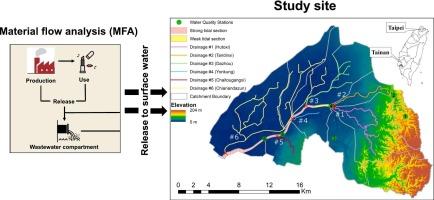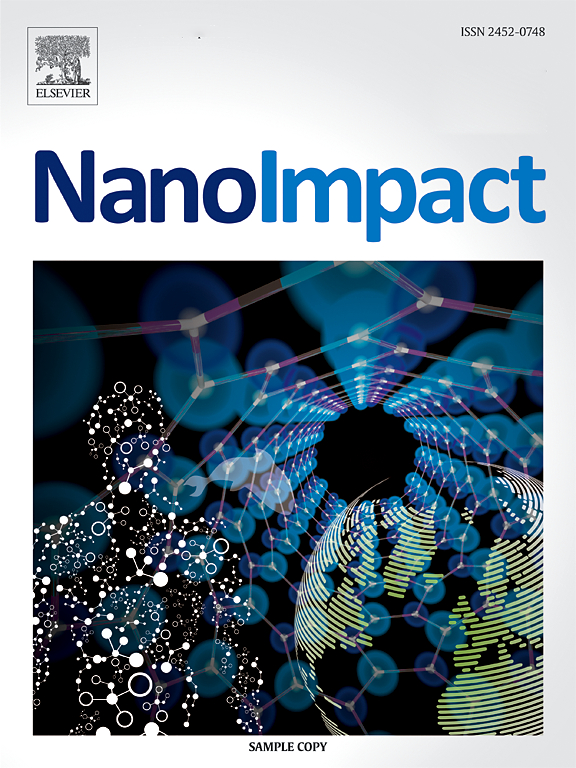模拟ZnO纳米颗粒在潮汐河中的命运和运输:将特定形式的物质流分析模型与水动力命运模型相结合
IF 5.5
3区 环境科学与生态学
Q2 ENVIRONMENTAL SCIENCES
引用次数: 0
摘要
以高空间分辨率预测工程纳米材料在现实环境条件下的环境命运,是对工程纳米材料在环境中的暴露进行高层次评估的关键。这一过程的一个关键步骤是将基于物料流分析(MFA)的释放评估与命运和运输模型联系起来。本文提出了一种新的模型,该模型将特定形式的概率物质流分析(PMFA)释放模型与高度时空分辨的命运和运输河模型耦合在一起。为了准确反映研究区(台湾南部一条沿海河流)的实际环境条件,模型中纳入了潮汐和实验得出的溶解速率的影响。PMFA结果表明,由于污水处理系统的覆盖范围有限,释放到地表水中的ZnO纳米粒子占释放到地表水中的ZnO纳米粒子总量的89%。溶解是ZnO纳米粒子在盐水河中主要的归宿过程,而异聚集作用不太重要。在放电点上,ZnO纳米粒子的浓度最高,达到0.9 μg/L。游离Zn离子是ZnO纳米颗粒衍生的主要产物,其平均稳态浓度可下游累积至7 μg/L。灵敏度分析表明,溶出速率为kdiss >; 3 d−1时溶出的重要性,而当kdiss≤0.1 d−1时,异聚集变得重要。潮汐对锌的分布有显著影响。在2个月的模拟时间内,涨潮使大负荷河段的Zn种积累量增加了3倍,而低潮使Zn种的羽状流失。本研究强调了生态风险评估中暴露评估的重要考虑因素,包括环境污染因子的释放形式,以及高度时空的命运和运输模型。本文章由计算机程序翻译,如有差异,请以英文原文为准。

Simulating the fate and transport of ZnO nanoparticles in a Tidal River: Coupling a form-specific material flow analysis model to a hydrodynamic fate model
Predicting the environmental fate of engineered nanomaterials (ENM) with high spatial resolution under realistic environmental conditions is key for a high-tier assessment of ENM exposure in the environment. A crucial step in this process is to link release assessments based on material flow analysis (MFA) with the fate and transport models. This paper presents a novel model that couples a form-specific probabilistic material flow analysis (PMFA) release model with a highly spatiotemporally resolved fate and transport river model. The effects of tides and the experimentally derived dissolution rate are incorporated into the modeling to accurately reflect the realistic environmental conditions of the study area, a coastal river in southern Taiwan. The PMFA results show that the pristine form of ZnO nanoparticles released into surface waters accounts for 89 % of the total ZnO nanoparticles released to surface waters, due to the limited coverage of the wastewater treatment system. Dissolution was the predominant fate process for ZnO nanoparticles in the Yanshuei River, while heteroaggregation was less important. Free ZnO nanoparticles only occurred sporadically and were noticeable at the discharge points, with the highest mean steady-state concentration of 0.9 μg/L. Free Zn ion was the major ZnO nanoparticles-derived product species, with an average steady-state concentration that can accumulate downstream to 7 μg/L. A sensitivity analysis indicated the importance of dissolution at dissolution rates kdiss > 3 d−1, while heteroaggregation became important when kdiss ≤ 0.1 d−1. The tides significantly affected the distributions of Zn species along the river. Within 2 months of simulation time, the high tide resulted in the accumulation of Zn species as much as 3 times higher at the river sections receiving large loads, while the low tide drained the plumes of Zn species. The study highlights the important considerations of the realistic local ENM release, including the ENM forms, in combination with the highly spatiotemporal fate and transport modeling, which is essential for the exposure assessment as a part of ecological risk assessment.
求助全文
通过发布文献求助,成功后即可免费获取论文全文。
去求助
来源期刊

NanoImpact
Social Sciences-Safety Research
CiteScore
11.00
自引率
6.10%
发文量
69
审稿时长
23 days
期刊介绍:
NanoImpact is a multidisciplinary journal that focuses on nanosafety research and areas related to the impacts of manufactured nanomaterials on human and environmental systems and the behavior of nanomaterials in these systems.
 求助内容:
求助内容: 应助结果提醒方式:
应助结果提醒方式:


